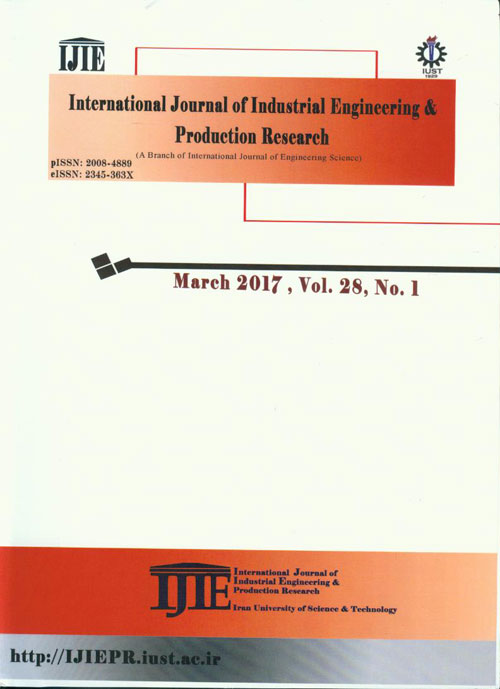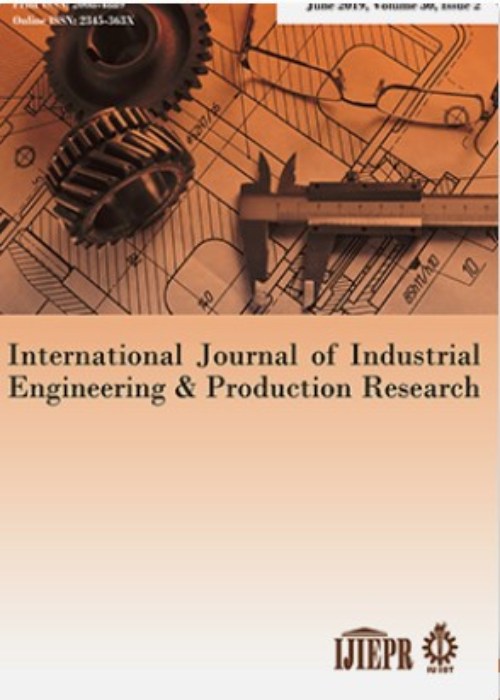فهرست مطالب

International Journal of Industrial Engineering and Productional Research
Volume:28 Issue: 1, Mar 2017
- تاریخ انتشار: 1396/04/01
- تعداد عناوین: 8
-
-
Pages 1-8In the current study, a dual-channel supply chain is considered containing one manufacturer and two retailers. It is assumed that the manufacturer and retailers have the same decision powers. A game-theoretic approach is developed to analyze pricing decisions under the centralized and decentralized scenarios. First, the Nash model is established to obtain the equilibrium decisions in the decentralized case. Then, the centralized model is developed to maximize the total profit of the whole system. Finally, the equilibrium decisions are discussed and some managerial insights are revealed.Keywords: E-commerce, Supply chain management, Dual-channel structure, Game theory, Nash equilibrium, Centralized model
-
Pages 9-20The present paper aims to propose a fuzzy multi-objective model to allocate order to supplier in uncertainty conditions and for multi-period, multi-source, and multi-product problems at two levels with wastages considerations. The cost including the purchase, transportation, and ordering costs, timely delivering or deference shipment quality or wastages which are amongst major quality aspects, partial coverage of suppliers in respect of distance and finally, suppliers weights which make the products orders more realistic are considered as the measures to evaluate the suppliers in the proposed model. Supplier's weights in the fifth objective function are obtained using fuzzy TOPSIS technique. Coverage and wastes parameters in this model are considered as random triangular fuzzy number. Multi-objective imperial competitive optimization (MOICA) algorithm has been used to solve the model,. To demonstrate applicability of MOICA, we applied non-dominated sorting genetic algorithm (NSGA-II). Taguchi technique is executed to tune the parameters of both algorithms and results are analyzed using quantitative criteria and performing parametric.Keywords: Multi-objective Supplier selection Problem, Maximal Coverage, Fuzzy Logic, Signal Function discount, MOICA, NSGA-II
-
Pages 21-31Recently, urbanization has been expanded rapidly in the world and a number of metropolitan areas have been appeared with a population of more than 10 million people. Because of dense population in metropolitan and consequently increasing the delivery of goods and services, there has been a lot of problems including traffic congestion, air pollution, accidents and high energy consumption. This made some complexities in distribution of urban goods; Therefore, it is essential to provide creative solutions to overcome these complexities. City logistics models can be effective in solving these complexities.
In this paper, concepts and definitions related to city logistics are explained to provide a mathematical model in order to design city logistics distribution network aim at minimizing response times. This objective is effective for goods and emergency services, especially in times of crisis and also for goods that are delivered as soon as possible. This is a three-level network and has been used in modeling of queuing theory. To validate the model, a numerical example has been established and results of the model have been explained using BARON solver in Gams software. Finally, conclusions and recommendations for future research are presented.Keywords: City Logistics, Urban Freight Distribution, City Distribution Centers, Network Design, Response Time, Queuing Theory -
Pages 33-45In this paper, we propose a vibration damping optimization algorithm to solve a fuzzy mathematical model for the single-item capacitated lot-sizing problem. At first, a fuzzy mathematical model for the single-item capacitated lot-sizing problem is presented. The possibility approach is chosen to convert the fuzzy mathematical model to crisp mathematical model. The obtained crisp model is in the form of mixed integer linear programming (MILP) which can be solved by existing solver in crisp environment to find optimal solution. Due to the complexity and NP-hardness of the problem, a vibration damping optimization (VDO) is used to solve the model for large-scale problems. To verify the performance of the proposed algorithm, we computationally compared the results obtained by the VDO algorithm with the results of the branch-and-bound method and two other well-known meta-heuristic algorithms namely simulated annealing (SA) and genetic algorithm (GA). Additionally, Taguchi method is used to calibrate the parameters of the meta-heuristic algorithms. Computational results on a set of randomly generated instances show that the VDO algorithm compared with the other algorithms can obtain appropriate solutions.Keywords: Single-item, Lot-sizing problem, Fuzzy mathematical model, Vibration damping optimization, Simulated annealing, Genetic algorithm
-
Pages 47-59Recently, sustainable supply chain management (SSCM) has become one of the important subjects in the industry and academia. Supplier selection, as a strategic decision, plays a significant role in SSCM. Researchers use different multi-criteria decision making (MCDM) methods to evaluate and select sustainable suppliers. In the previous studies, evaluation is solely based on the desirable features of suppliers and their risks are neglected. Therefore, current research uses failure mode and effects analysis (FMEA) as a risk analysis technique to consider supplier's risk in combination with the MCDM method. Practically, this study operated in two main stages. In the first stage, the score of the suppliers obtains by integration Fuzzy MOORA and FMEA. In the second stage, the output of the previous stage used as input parameters in developed mix-integer linear programming to select suppliers and order optimum quantity. Finally, to demonstrate the effectiveness of the proposed approach, a case study in a chemical industry and sensitivity analysis is presented.Keywords: Supplier selection, Sustainability, Fuzzy MOORA, FMEA, Order allocation
-
Pages 61-74In hybrid flow shop scheduling problem (HFS) with unrelated parallel machines, a set of n jobs are processed on k machines. A mixed integer linear programming (MILP) model for the HFS scheduling problems with unrelated parallel machines has been proposed to minimize the maximum completion time (makespan). Since the problem is shown to be NP-complete, it is necessary to use heuristic methods to tackle the moderate to large scale problems. This article presents a new bottleneck-based heuristic to solve the problem. To improve the performance of the heuristic method, a local search approach is embedded in the structure of the heuristic method. To evaluate the performance of the proposed heuristic method, a new lower bound is developed based on Kurz and Askin [1] lower bound. For evaluation purposes, two series of test problems, small and large size problems, are generated under different production scenarios. The empirical results show that average difference between lower bound and optimal solution as well as lower bound and heuristic method are equal to 2.56% and 5.23%, respectively. For more investigation, the proposed heuristic method is compared by other well-known heuristics in the literature. The results verify the efficiency of the proposed heuristic method in term of number of best solution.Keywords: bottleneck-based heuristic, lower bound, hybrid flow shop, makespan
-
Pages 75-84Given the increasing number of documents, sites, online sources, and the users desire to quickly access information, automatic textual summarization has caught the attention of many researchers in this field. Researchers have presented different methods for text summarization as well as a useful summary of those texts including relevant document sentences. This study selects extractive method out of different summarizing methods (e.g. abstract method). Extractive method involves summarizing text through objective extraction of some parts of a text like word, sentence, and paragraph. A summarization issue would be unsolvable by exact methods in a reasonable time with considering documents with high amount of information (NP complete). These kinds of issues are usually solved using metaheuristic methods. A biogeography-based optimization algorithm (BBO), which is a new metaheuristic method in the domain of extractive text summarization, is used in this article.Keywords: Automatic Text Summarization, Biogeography-based optimization algorithm, Extractive Method, Online Sources, NP complete
-
Pages 85-94Nowadays, the popularity of social networks as marketing tools has brought a deal of attention to social networks analysis (SNA). One of the well-known Problems in this field is influence maximization problems which related to flow of information within networks. Although, the problem have been considered by many researchers, the concept behind of this problem has been used less in business context. In this paper, by using a cost-benefits analysis, we propose a multi-objective optimization model which helps to identify the key nodes location, which are a symbol of potential influential customers in real social networks. The main novelty of this model is that it determines the best nodes by combining two essential and realistic elements simultaneously: diffusion speed and dispersion cost. Also, the performance of the proposed model is validated by detecting key nodes on a real social networkKeywords: Social network analysis, Influence Maximization, diffusion Speed, Multi-objective optimization


